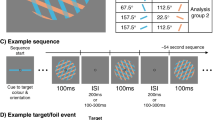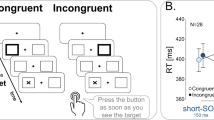Abstract
VISUAL–SPATIAL attention is an essential brain function that enables us to select and preferentially process high priority information in the visual fields1,2. Several brain areas have been shown to participate in the control of spatial attention in humans3–5, but little is known about the underlying selection mechanisms. Non-invasive scalp recordings of event-related potentials (e.r.ps) in humans have shown that attended visual stimuli are preferentially selected as early as 80–90 ms after stimulus onset6,7, but current e.r.p. methods do not permit a precise localization of the participating cortical areas. In this study we combined neuroimaging (positron emission tomography) with e.r.p. recording in order to describe both the cortical anatomy and time course of attentional selection processes. Together these methods showed that visual inputs from attended locations receive enhanced processing in the extrastriate cortex (fusiform gyrus) at 80–130 ms after stimulus onset. These findings reinforce early selection models of attention8–10.
This is a preview of subscription content, access via your institution
Access options
Subscribe to this journal
Receive 51 print issues and online access
$199.00 per year
only $3.90 per issue
Buy this article
- Purchase on Springer Link
- Instant access to full article PDF
Prices may be subject to local taxes which are calculated during checkout
Similar content being viewed by others
References
Hawkins, H. L. et al. J. exp. Psychol. Hum. Percept. Perform. 16, 802–811 (1990).
Van der Heijden, A. Selective Attention in Vision (Routledge, London, 1992).
Posner, M. I. & Petersen, S. E. A. Rev. Neurosci. 13, 25–42 (1990).
Posner, M. I. & Driver, J. Curr. Opin. Neurobiol. 2, 165–169 (1992).
LaBerge, D. J. cogn. Neurosci. 2, 358–372 (1990).
Hillyard, S. A. Curr. Opin. Neurobiol. 3, 217–224 (1993).
Mangun, G. R., Hillyard, S. A. & Luck, S. J. in Attention and Performance XIV (eds Meyer, D. & Kornblum, S.) 220–243 (MIT Press, Cambridge, MA, 1993).
Broadbent, D. A. Perception and Communication (Pergamon, New York, 1958).
Posner, M. I., Snyder, C. R. R. & Davidson, B. J. J. exp. Psychol. Gen. 109, 160–174 (1980).
Treisman, A. Quart. J. exp. Psychol. 40, 201–237 (1988).
Heinze, H. J. et al. Percept. Psychophys. 56, 42–52 (1994).
Jeffreys, D. A. & Axford, J. G. Expl Brain Res. 16, 1–21 (1972).
Scherg, M. & Berg, P. Brain Topogr. 4, 143–150 (1991).
Gomez Gonzalez, C. M., Clark, V. P., Fan, S., Luck, S. J. & Hillyard, S. A. Brain Topogr. (in the press).
Ungerleider, L. G. & Mishkin, M. in Analysis of Visual Behavior (eds Ingle, D. J., Goodale, M. A. & Mansfield, R. J. W.) 549–586 (MIT Press, Cambridge, MA, 1982).
Tanaka, K., Sugita, Y., Moriya, M. & Saito, H. J. Neurophysiol. 69, 128–142 (1993).
Zeki, S. et al. J. Neurosci. 11, 641–649 (1991).
Fischer, B. & Boch, R. Brain Res. 345, 111–123 (1985).
Moran, J. & Desimone, R. Science 229, 782–784 (1985).
Spitzer, H., Desimone, R. & Moran, J. Science 240, 338–340 (1988).
Motter, B. C. J. Neurophysiol. 70, 909–919 (1993).
Petersen, S. E., Fiez, J. A. & Corbetta, M. Curr. Opin. Neurobiol. 2, 217–222 (1992).
Corbetta, M., Miezin, F. M., Dobmeyer, S., Shulman, G. L. & Petersen, S. E. J. Neurosci. 11, 2383–2402 (1991).
Petersen, S. E., Corbetta, M., Miezin, F. M., Shulman, G. L. & Raichle, M. E. in Brain Mechanisms of Perception and Memory: From Neuron to Behavior (eds Ono, T., Squire, L., Perrett, D. & Raichle, M. E.) 413–425 (Oxford Univ. Press, New York, 1993).
Corbetta, M., Miezin, F. M., Shulman, G. L. & Petersen, S. E. J. Neurosci. 13, 1202–1226 (1993).
Desimone, R., Wessinger, M., Thomas, L. & Schneider, W. in Cold Spring Harb. Symp. quart. Biol. 963–971 (1992).
Worsley, K. J., Evans, A. C., Marret, S. & Neelin, P. J. Cereb. Blood Flow Metab. 12, 900–918 (1992).
Talairach, J. & Tournoux, P. Co-planar Stereotactic Atlas of the Human Brain 2nd edn (Thieme, Stuttgart, 1988).
Friston, K. J. et al. J. Cereb. Blood Flow Metab. 9, 690–695 (1989).
Fox, P. T. & Mintun, M. A. J. nucl. Med. 30, 141–149 (1989).
Author information
Authors and Affiliations
Rights and permissions
About this article
Cite this article
Heinze, H., Mangun, G., Burchert, W. et al. Combined spatial and temporal imaging of brain activity during visual selective attention in humans. Nature 372, 543–546 (1994). https://doi.org/10.1038/372543a0
Received:
Accepted:
Issue Date:
DOI: https://doi.org/10.1038/372543a0
This article is cited by
-
Acute aerobic exercise benefits allocation of neural resources related to selective attention
Scientific Reports (2023)
-
A brain-based general measure of attention
Nature Human Behaviour (2022)
-
The role of task demands in racial face encoding
Scientific Reports (2022)
-
Gender Role, But Not Sex, Shapes Humans’ Susceptibility to Emotion
Neuroscience Bulletin (2021)
-
Induced Beta Power Modulations during Isochronous Auditory Beats Reflect Intentional Anticipation before Gradual Tempo Changes
Scientific Reports (2020)
Comments
By submitting a comment you agree to abide by our Terms and Community Guidelines. If you find something abusive or that does not comply with our terms or guidelines please flag it as inappropriate.



